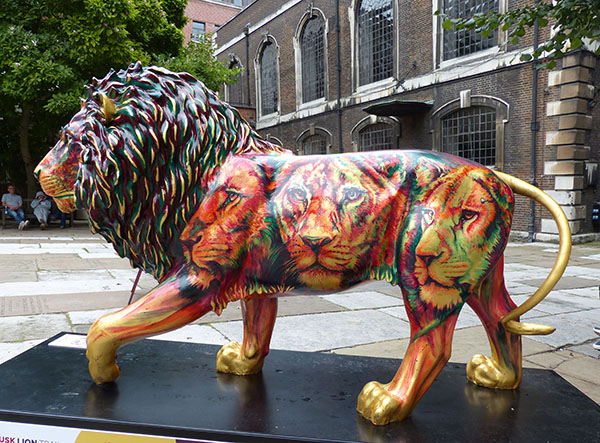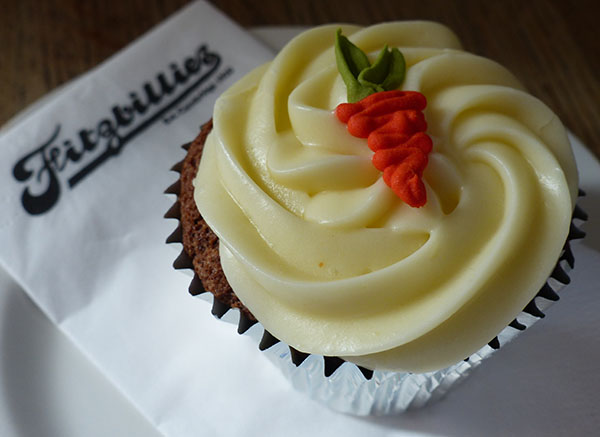Twenty-seven lion sculptures painted by different artists, comedians, and musicians have appeared across West London and other parts of the world to raise charity for Tusk's conservation projects involving lions and other African species. Lions are under threat by humans taking their lands, and their numbers have decreased rapidly in the past 25 years. The Tusk Lion Trail launched in the middle of August, and the lions will be on display until the 24th of September. In total, there are 47 in total, but only 27 of these are located primarily in West London.


"London Pride" - Adam Dant and "Why Oh Why Oh Why" - Jake Chapman
Adam Dant is an artist known for his illustrations of detailed maps. The lion is inspired by the pubs that use the word "lion" in the title, and maps of popular "lion" pubs appears on the side.
Jake Chapman is a visual artist who creates shocking work using different media with gruesome scenes around popular subjects from politics to fast food restaurants to oddities.

"Ripping / Cuddling" - Sara Shamma
Sara Shamming is a UK-based artist who uses themes of human emotions in her work, covering tricky subjects like war and human slavery.

"Protect Me" - Sally Wood with Jess Power
Sally Wood is an actress and producer who is on the board at the Roundhouse Theatre. She is married to Ronnie Wood of The Rolling Stones fame. Jess Power is an artist that worked with Sally Wood to create the artwork inspired by "The Lion King".

"English King" - Glen Baxter
The English garden and kings are celebrated with this green tropiary-style lion. Glen Baxter is an artist whose work is on display around the world.

"Big Blue" - John Illsley
Founding member of the band Dire Straits, John Illsley, has created "Big Blue", inspired by the nobility of the lion.

"Manebow" - Patrick Hughes and "Rose Lion" - Rob & Nick Carter
Patrick Hughes was born during World War II and is a soloist. The rainbow-maned lion is to add more rainbows to the world.
Rob and Nick Carter are an artistic husband and wife duo who create artwork using a lot of bright colour. Mediums include light, painting, film, and photography. During the lockdown, they became inspired by visits to Hyde Park to capture the roses.

"Limited Edition" - Mauro Perucchetti and "Untitled" - Michael Foreman
Italian painter Perucchetti was born in 1949, and his work is inspired by society and environment with the lion no longer being the king due to environmental concerns.
Michael Foreman is an author and illustrator born during World War II and has created over 250 books.

"Long Live That Lion" - Prof Gerry McGovern OBE
Creative Officer for Jaguar Land Rover Gerry McGovern created this lion. The colours represent the vivid African sunsets of their habitat, and the chrome represents the industry that is causing their numbers to decline.

"Brian the Lion" - Hannah Shergold
Hannah Shergold is a helicopter pilot for the army. Since leaving the army in 2018, she has produced artwork and raised money for charity successfully. The artwork asks the worth of the lion and inspires us to think about its whole ecosystem and place in the world.

"Kamuro" - Ian Davenport
Davenport's artwork is shown in many high-profile museums across the globe, and he has been nominated for a Turner Prize. This lion is created using the artist's "Splat" series.

"Nathan" - Helen Downie AKA Unskilled Worker
Fantasy elements are used with natural elements in Helen Downie's artwork.

"Not Lying Lion" - Ronnie Wood
Guitarist of the band The Rolling Stones and a song-writer, Ronnie Wood also has art training. The lion hopes to inform about the lions becoming endangered.



"A Hard Mane is Gonna Fall" - Noel Fielding
Actor, comedian and artist Noel Fielding created many character designs for "The Mighty Boosh" and collaborated with a menswear collection.

"Signs of the Times" - David Mach
David Mach is known for large-scale artwork using different objects. Familiar symbols are used to describe the lion.

"The Return of the Urban Casual" - Ray Richardson
The artist Ray Richardson painted different artistic scenes on both sides of the lion.

"Azami" - Dr. Haruhisa Handa
Japanese businessman and spiritual leader Handa has created the artwork titled "azami", which translates as "thistle".

"Pilgrim" - John Cleese and Jen Wade
Comedian John Cleese has created "Pilgrim" with his wife named Fish. The rainbow mane signifies hope and dreams, and the fish is a symbol that is a tribute to Cleese's wife.

"Wild Roots" - Nick Gentry
Consumer waste, pop culture, and found art are popular subjects of the artist. The artwork is inspired by the wild roots of the lion, which humans have in common.

"Blue Lion" - Gavin Turk
One of Turk's artistic styles is to make the sculptures look like giant toys. The lion sculpture appears to be made as a plastic toy animal.

"Golden Wonder" - Matthew Horne and "Suffering Saviour" - George Morton-Clark
Matthew Horne is an actor and writer for the BBC, and he is known for playing Gavin on "Gavin and Stacey", The Catherine Tate Show, Bad Education, and others.
George Morton-Clark created the lion based on the "Looney Tunes" character Sylvester the cat. The cat's catchphrase is "Suffering succotash".

"Sirkon" - Paul Onditi
Kenyan artist Paul Onditi is an artist making an impact currently, and his work is inspired by human and nature contact with humans living close to national parks and living in close proximity to wildlife, such as lions.

























































































































































































































































































































Recent Comments